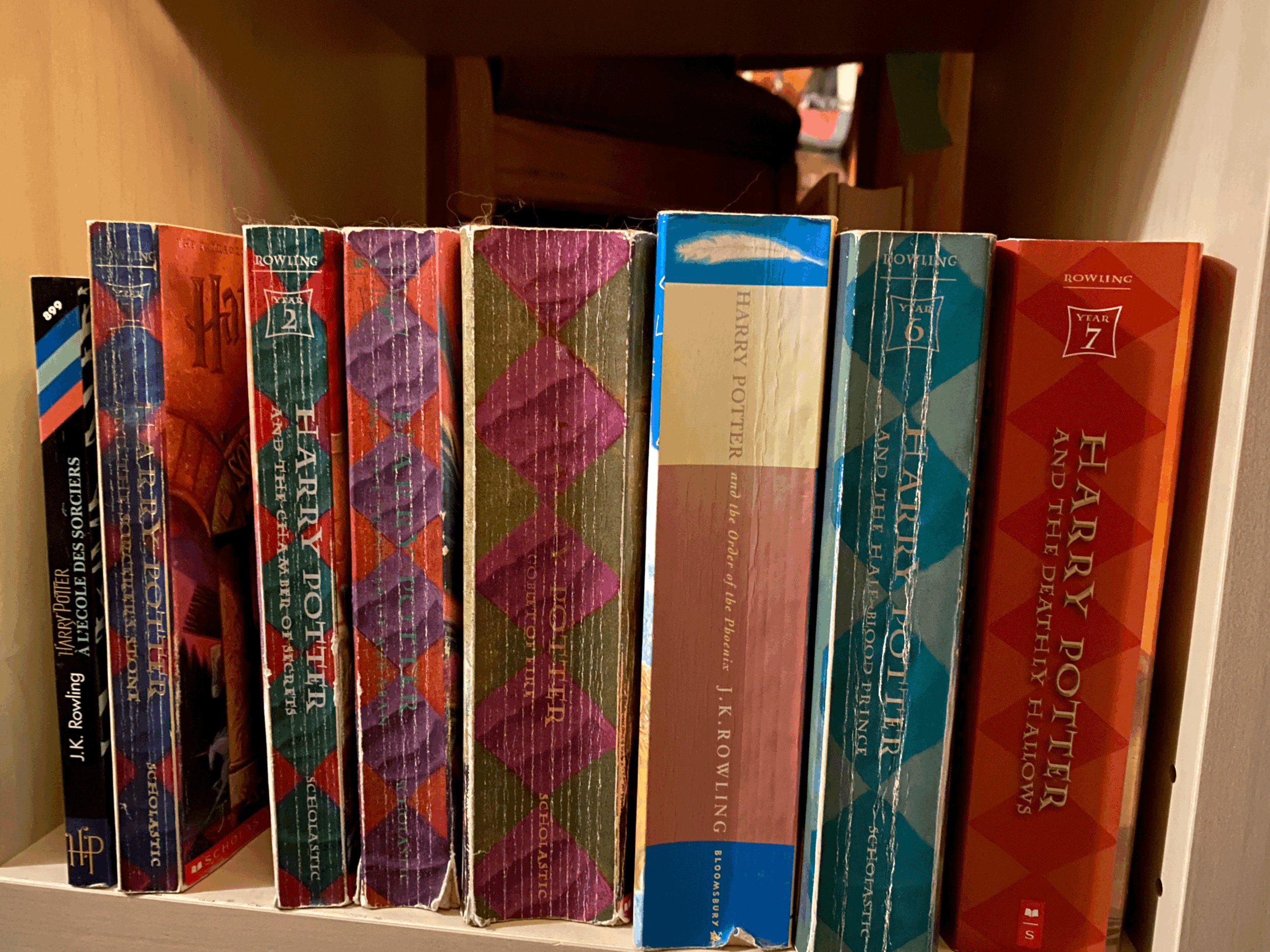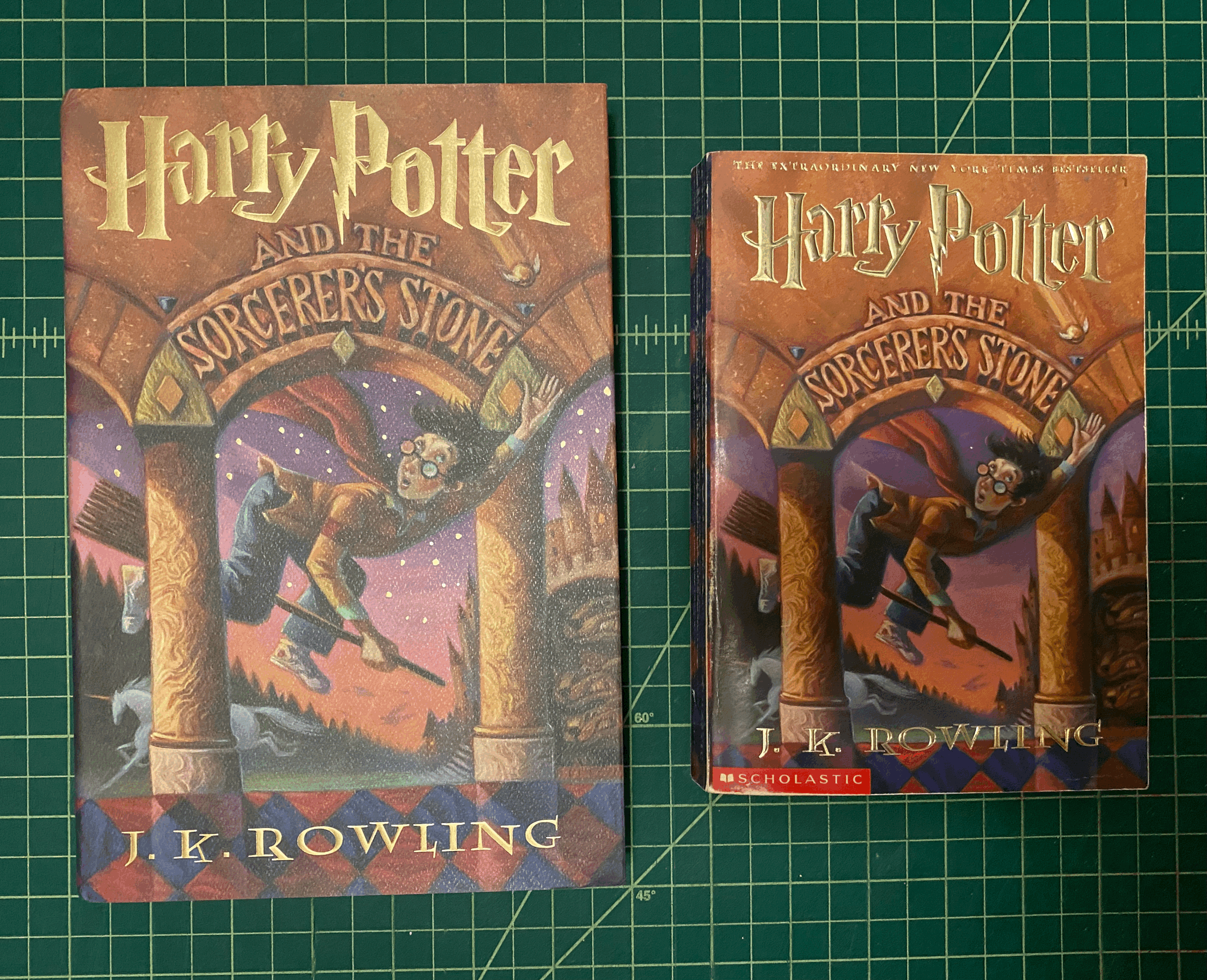The seven Harry Potter books in paperback (with a French edition) on a bookshelf
There’s a lot to be said about the Harry Potter series, this is my connection to them and a look at a few of the differences between editions.
The first Harry Potter book was released in the US shortly before I entered high school (yup, I’m a “geriatric millennial”) and by that time it was already retitled Harry Potter and the Sorcerer’s Stone (it’s common knowledge that it was first titled Harry Potter and the Philosopher’s Stone). It was popular bookish fiction and I was an angsty bookish pre-teen and did not read what everyone else read. But no one would stop talking about it. And then the movies started coming out; I didn’t watch them either. The summer before college a friend finally managed to convince me by saying something like “look, it’s a short book, try the first one and if you hate it, you never have to pick up another one again.” Challenge accepted. I devoured the first book in a day, the second one the next day, the third one the day after that. By the end of the week I was done with the fourth and anxiously awaiting both moving away to college and the fifth release. I bought my paperback copy of Order of the Phoenix in London while studying Shakespearan literature and art history over winter break. I was at the midnight release of the sixth book and devoted for a week about its ending. I was at the midnight release for the seventh book and took forever to read it because I didn’t want the series to end. The movies or the movie soundtracks are almost always on repeat in my home, it drives my partner, a hardcore horror movie and death metal fan, nuts. Needless to say, I smitten with the series and have been sorted into Gryffindor via the Wizarding World even though my Hogwarts letter never arrived. The series has been as widely criticized as it has been celebrated but as a queer teen who never fit in, it was a welcome escape.
The front covers of the hardcover and paperback editions of Harry Potter and the Sorcerer’s Stone
Comparing editions
For a book that remains on bookstore shelves nearly 25 years later, it’s safe to assume there have been multiple printings. Things are likely to change during this time so let’s take a peek at some differences.
It’s not uncommon for any book, especially a popular one, to undergo changes throughout the course of its publishing. Heck, Lewis Carroll designed and published four different editions of Alice’s Adventures in Wonderland within five years of its first publication date (Lastoria, 2019). The differences in Harry Potter are a bit more gradual. The first hardcover edition of Harry Potter and the Sorcerer’s Stone was released in 1997 and the paperback followed in 1998. A quick glance at the covers shows little difference. The paperback doesn’t have a dust jacket but instead its cover has the identical illustration from the dust jacket of the hardcover version. While the hardcover only has the published displayed on the spine, the paperback prominently features a red Scholastic logo. While the descriptions are identical (inside front dust jacket leaf- hardcover; back cover- paperback), the paperback also lists various awards the story received in the year following its release. Scholastic is a bit more proud of it now, eh?
Both editions use the exact same typefaces, illustrations, and ornaments and both books clock in at 309 pages. Post story, the paperback features an advertisement for the next chapter in the saga: Harry Potter and the Chamber of Secrets. But wait, there’s more!
I bought the paperback editions of this collection because I wanted to be able to re-read the books again and again and again. And again. I commute by BART and public transit and hardcovers are just cumbersome and more expensive to replace. Plus, I’m a bookbinder and I could always repair or rebind the paperback. What makes this paperback cheaper? It’s smaller; yeah, that’s part of it. It uses less material (smaller and no boards needed for a cover); yup that too. Hint: look inside! Paperbacks, especially those printed by Scholastic, are printed and cheaper [and therefore poorer quality] paper stock (Ellis, 2021). You don’t need to read an article about the problems with Scholastic to realize the paperback isn’t the same quality, you can see it with your own eyes. Despite being only a year apart in age, my paperback pages are brownish and turning an unpleasant brownish-orange from the edges inward. Meanwhile, the hardcover pages are still pristine white. Both books have traveled together from Connecticut to Savannah, GA to San Francisco and inhabited the same shelves, clearly the paper stock is to blame. Cheaper papers tend to be more acidic and are basically degraded from the time they are made. Should we stop producing paperbacks? Hell no! That would only limit access to books given the higher price of hardcover versions. We should just be wary of the means of production and how they’ll alter a book over time.
Other editions of The Sorcerer’s Stone have come out, of course. There’s one that creates Hogwarts across the spine of all seven books, an edition I recently rebound for a friend had a map of Hogwarts I had never seen before, and of course there are design bindings. As the franchise carries on and expands into the digital world, it’ll be very interesting indeed for this book historian to follow its evolution.
Citations (not linked above)
Lastoria, A. (2019). Lewis Carroll, art director: Recovering the design and production rationales for Victorian editions of Alice’s Adventures in Wonderland. Book History, 22. pages 196-222.


